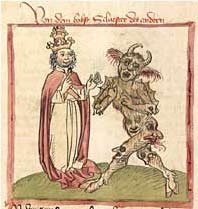- About MAA
- Membership
- MAA Publications
- Periodicals
- Blogs
- MAA Book Series
- MAA Press (an imprint of the AMS)
- MAA Notes
- MAA Reviews
- Mathematical Communication
- Information for Libraries
- Author Resources
- Advertise with MAA
- Meetings
- Competitions
- Programs
- Communities
- MAA Sections
- SIGMAA
- MAA Connect
- Students
- MAA Awards
- Awards Booklets
- Writing Awards
- Teaching Awards
- Service Awards
- Research Awards
- Lecture Awards
- Putnam Competition Individual and Team Winners
- D. E. Shaw Group AMC 8 Awards & Certificates
- Maryam Mirzakhani AMC 10 A Awards & Certificates
- Two Sigma AMC 10 B Awards & Certificates
- Jane Street AMC 12 A Awards & Certificates
- Akamai AMC 12 B Awards & Certificates
- High School Teachers
- News
You are here
Gerbert d'Aurillac and the March of Spain: A Convergence of Cultures - Gerbert's Legacy
We have seen that Gerbert was truly a man in the right place at the right time: his study in the Spanish March in the tenth century introduced him to mathematical ideas from Latin, Arabic, Indian, and Jewish scholars. He was instrumental in introducing Hindu-Arabic numerals to Western Europe. He taught a generation of students about the astrolabe and the abacus. His knowledge was so surprising, so new and different, that some people accused him of obtaining it through supernatural, or even demonic, means. William of Malmesbury, writing one hundred years later, calmly stated that Gerbert studied astrology with the Arabs and learned magical arts from them. Some of the more colorful legends that grew up about Gerbert were that he could fly, that he had a mistress who was a witch, that he constructed a huge talking head who gave him the answers to mathematics problems. Even today, his tomb is reputed to weep upon the death of a pope.

Despite his notoriety, Gerbert was elected Bishop of Rome in the year 999; the name he chose as pope, Sylvester II, honors the first Sylvester, who – according to legend – baptized Constantine, the first Christian Roman emperor. And so even Gerbert’s choice of a papal name combined Christian and pagan legacies.
Gerbert’s home town of Aurillac now proudly claims him as a native son. There is a statue of him in that city, honoring the young man who left his humble home to travel to a new land, where he learned mathematics so strange and wonderful that it brought him to the attention of the most powerful men in Europe – until finally he became one of them.

Betty Mayfield (Hood College), "Gerbert d'Aurillac and the March of Spain: A Convergence of Cultures - Gerbert's Legacy," Convergence (August 2010)




